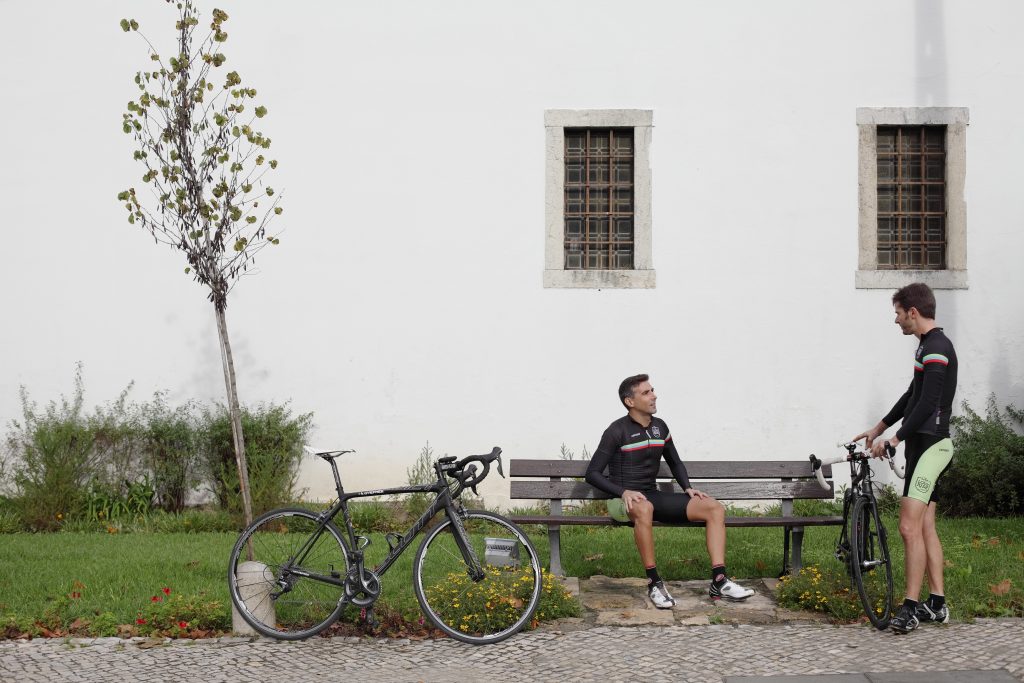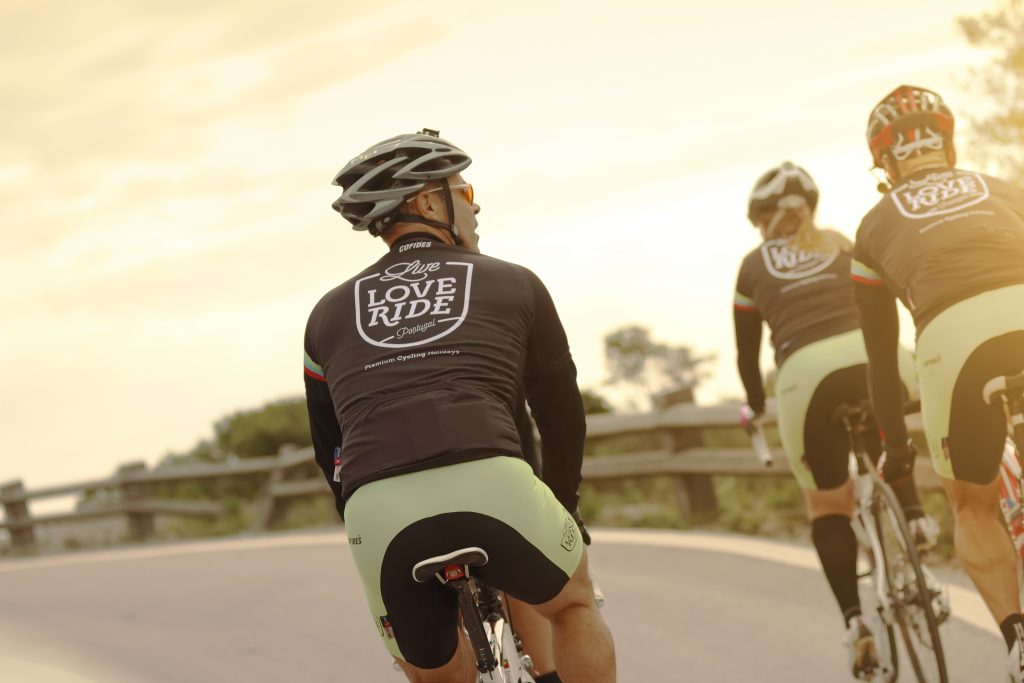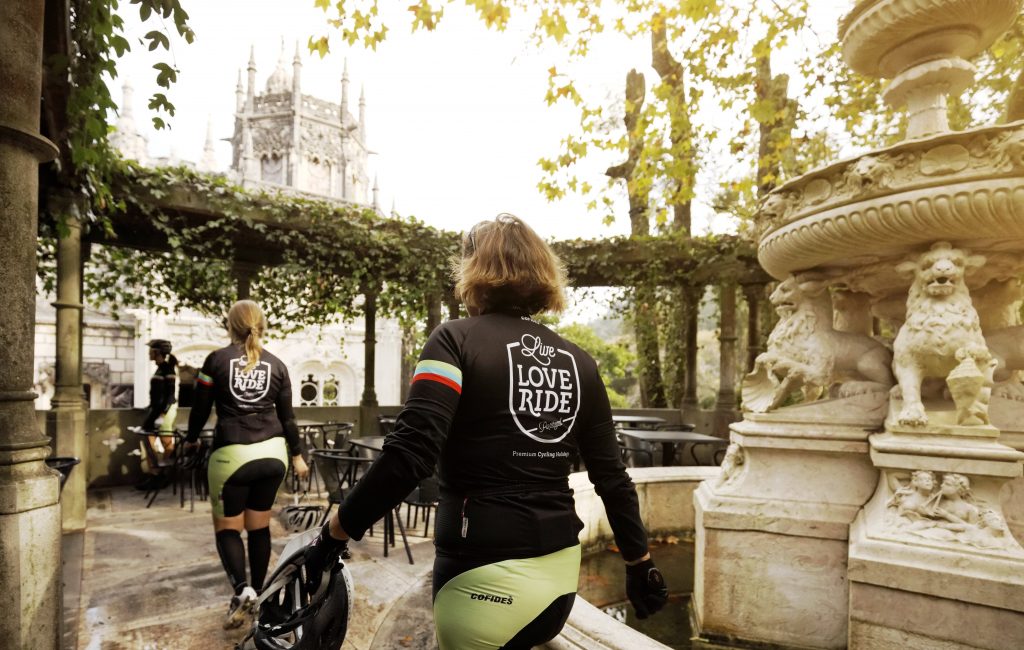Ricardo, a Live Love Ride founder and resident guide on our half-day Lisbon road cycling tours, was born and raised in Lisbon. As a “weekend warrior” himself, most of his rides start from Lisbon and head into Sintra Sierra, a local favorite among the local roadies. Here are his suggestion for a ride starting from Lisbon to explore Sintra, that you can follow on your own to discover his favorite roads and spots:
When we talk about one of the classic rides for the Lisbon road cyclists, the Sintra Loop is the first one to pop to every local rider’s mind.This is a super scenic coastal ride that has everything, a flat start to warm up, a mid ride challenging climb all the way to Sintra, a fast downhill section leading you to the coast again and then the flat ocean road back to Lisbon. This road cycling loop has a total of 105km and 1000m of total climbing.
From Lisbon, the best time to ride this loop is early morning on a weekend as you don’t want to meet the weekdays traffic coming in and out of Lisbon. So, start early, somewhere around 7:30AM, making your over the Lisbon hills to the river and head west on the 2 lane avenues along the river towards Cascais. The route follows below:
As you start to ride out of the city of Lisbon, the road will be closer to the river and you’ll start to have some views of the water. Once you go past the National Stadium and tackle one of the few short hills by river, you’ll get to the top of Alto da Boa Viagem where you’ll have the first full view of the Tejo River mouth and the Atlantic Ocean, guarded by the Bugio lighthouse, that commands the river entrance from the diminutive river island. At this time you’ll be riding in the Marginal road, a wide 4 lane road that you have to share with cars, motorcycles and lorries, so our advice is to ride in a peloton or small group being considerate to ride single file if there’s moderate traffic. If you started early morning this won’t be an issue.
Along the Marginal you’ll be riding all the way to Cascais along the river, quickly passing small beach towns like Santo Amaro de Oeiras, Carcavelos and Estoril, that grew to become one sprawling urban area of mostly houses, bungalows and low rise buildings, all trying to get the best views of the river and the sea, and that connect Lisbon and Cascais. Passing Carcavelos, which has the longest and widest beach of this coastal area, you’ll notice the surf crowds that are usually out early morning to enjoy the gentle waves of this beach and already some beachgoers arriving, especially in the summertime. After Carcavelos you’ll go through Estoril, the 1940’s seaside royal’s exile and spy nest of Europe during the hard times of the Second World War and nowadays best known as a playground for the high heeled locals and tourists, with the beach coves, clubs, casino and the Formula 1 race circuit. This once small beach town is now connected to Cascais and you’ll notice a bit more traffic as you approach and enter Cascais. It still has its charm of yesteryears as a quaint village where the Queen would come to spend her time with her maidens and children at the beach, but it also grew as a touristic area with great hotels and a Marina on the bay. Here as you enter the village keep oceanside, heading to the Marina, through the Pescadores Beach and up the small hill to enter the Guincho road.
The Guincho road is probably the most cycled route of the Lisbon area as it has a nicely maintained cycle/walking path that will have some runners already even early in the morning. It’s your choice to use it or not, as the road won’t have much, if any traffic. This is also one of the most beautiful areas to road cycling too, as you’ll have the deep blue ocean on your left and the majestic and protected dunes on your right while as you cycle you’ll start having the incredible views of the Sintra mountains and the Cabo da Roca (Roca Cape), the westernmost place of continental Europe. Believe me, on a clear sunny day, the view is no short of just magnificent. If you’re lucky there’s no wind, but let me just warn you that you’ll have to be really lucky, since this area of the coast is notorious for its north-western winds that will hit you right in the face the moment you contour the coast from the west to the north on your way to Guincho Beach. If it’s windy just soldier on, pace yourself and your group on that 8km ocean road stretch until you get to Guincho Beach, the entry gate the Sintra mountain and natural park and the start of the climb to the Cape. Here a group photo might be in order as the setting is perfect, with the beach, the dunes, the ocean and the Sintra natural Park behind. If you really want to take in the views you should head to the Duna da Cresmina (the Cresmina Dune) where you’ll find a nice café on the top of the Dune that has a commanding view over this area. Have a coffee or a tea and let the views sink in. Get back on your bike and start to tackle the climb to Azóia/Roca Cape. This is a climb that you can roughly divide in 2; the first 3km will get you from Guincho to the village of Malveira da Serra, a constant 6% climb with one short flat area to rest your legs, and then the last 3km with a little more incline in some areas but 2 longer flat stretches to rest the legs and prepare the final push to Azóia. The first part is through the eucalyptus and pine grove area of Abano and Malveira, with some wide corners and long straights and as you enter Malveira it gets windier and the view over Guincho and the coast is amazing. I’m sure there will be a stop or two for photos.

Once you get to Azóia, you have the choice of turning left towards the Roca Cape, a 3km downhill section (and then uphill on the way back) that will take you to the salty wind battered cape overlooking the deep blue Atlantic Ocean from the top of the cliffs, always a surprising and sensorial experience, or you can just continue to Colares along the forested area of the park. The forest area starts with a gentle downhill section, followed by a flat-ish stretch and then a steep, narrow and windy section of 5km where you should be careful due to the morning dew you commonly find on the road in this shaded area of the park. Once in Colares you’ll be at the base of the park, with the mountain on your right. This little town has several cafés on the side of the road where you can stop for a snack or refill your water bottle.
From Colares, there’s no way but up, especially if you want to get to Sintra, the question is how steep you want it to be. We advise you to head on your way along the narrow windy road gently uphill that goes past Galamares and then climbs to Sintra, a road that runs parallel to the tram lines that connect Sintra with the Maçãs Beach. This is a 3km gentle climb of 4% that you should ride in single file as it will have some traffic already and the road is narrow.
When you arrive at the roundabout at the entrance of Sintra head up and once you go past the Museum of Ancient Art take a right and then a left to get you to the city’s historic centre. There are plenty of traffic constraints nowadays but as you are road cycling, you can ride all the way to the palaces and gardens area as long as you obey the traffic signs and one way streets. So make your way through the Volta do Duche, a road parallel to 2 of the many gardens and parks of this historic area and arrive at the Sintra National Palace, an iconic 15th century building of this UNESCO World Heritage Site that is Sintra. Admire this “Old Palace” and the views of the city from the entrance courtyard, a great place for some scenic photos too, and head to the local pastry shop Periquita to have a “travesseiro”, a sweet egg based local pastry that’s both delicious and a great energy booster for the rest of the ride. They have 2 shops 100m from the “old palace” on the narrow pedestrians only street in front of the palace.

After you wolf down the sweet pastries you can take the opportunity to see some of the other historic monuments in town, so ride to Palácio de Seteais continuing on the Volta do Duche street passing Lawrence’s Hotel, probably the oldest working hotel in Portugal and make your way up the very steep street that passes the Regaleira Palace that you’ll be able to admire better on the way down!

Once you tackle the steep but short climb you’ll arrive at Seteais Palace on your right, an 18th century building, one of the first palaces in Sintra, with a neoclassic style an ample garden at the entrance and that today is a working luxury hotel. Enter the garden and ride till the arch connecting the building, walking up to the lookout point. From here you’ll be able to admire the views of the back garden and coastal area, and if you look back, you’ll find a magnificent view to the Pena Palace. Trace your way back to the same road and head back downhill to the Sintra and on the way don’t forget to stop to admire the Regaleira Palace, an impressive 19th century folly of a mansion with magnificent architecture and marvellous gardens. Continue downhill and follow the one way street out of the historic area, a steep and short climb again that will take you to the São Pedro de Penaferrim area where we suggest you to stop at Café da Natália where you can enjoy your coffee, amazing pastries and cakes at the sunny outside sitting area.
After you refill and replenish start to make your way back to Estoril, a long gentle ride downhill along a dual carriageway road where you should ride single file. This road will take you around the Sintra natural park and mountain range, passing the Estoril F1 circuit and joining the ocean road next to the Estoril Casino.
The ocean road marks the end of the downhill section and you’ll turn left towards Lisbon, the same coastal road that brought you to Cascais is the same you’ll ride back. It’s a flat-ish road with only a couple of very short hills that mid-morning should have some moderate traffic, so please be careful, ride single file close to the shoulder and beware of the several beach entries/exits all the way to Lisbon. Once you get to Lisbon you can consider taking a right up the flyover right after you pass Algés, where you can ride on the road closer to the river, passing some iconic monuments like the Belém Tower and Padrão dos Descobrimentos both marking the Portuguese ocean exploration of the 15th and 16thcenturies.
You can consider having lunch in one of the many riverside restaurants that you’ll find as soon as you reach the Belém tower. There are plenty to choose from, modern Portuguese, Japanese, Italian, seafood and fresh fish, regional Portuguese, and meat lovers restaurants all the way from Belém to Cais do Sodré, you just have to pick your poison and enjoy a relaxed lunch by the river.
If you are in Lisbon and would like to go on a ride with Ricardo towards Sintra or Arrábida, be sure to check out our half or full-day Lisbon road cycling tour.